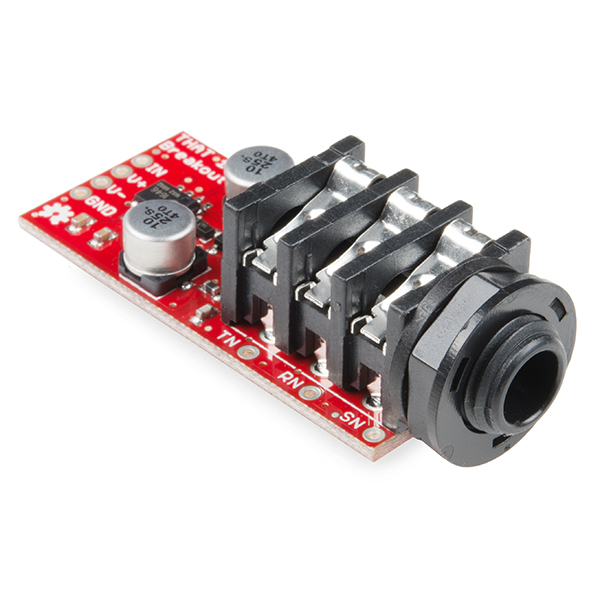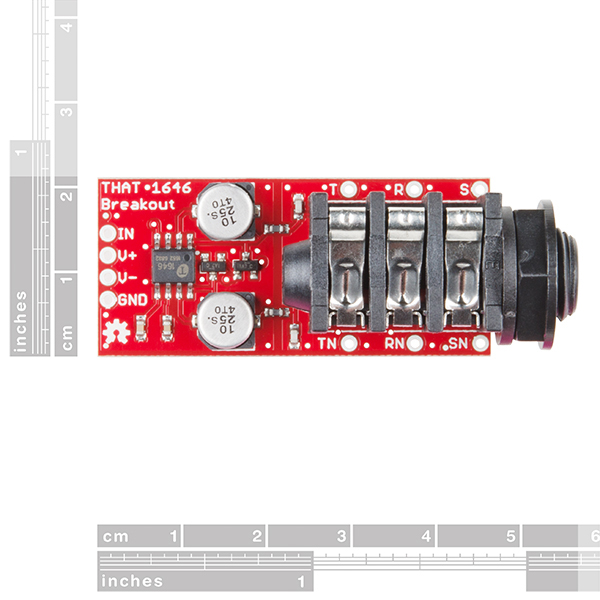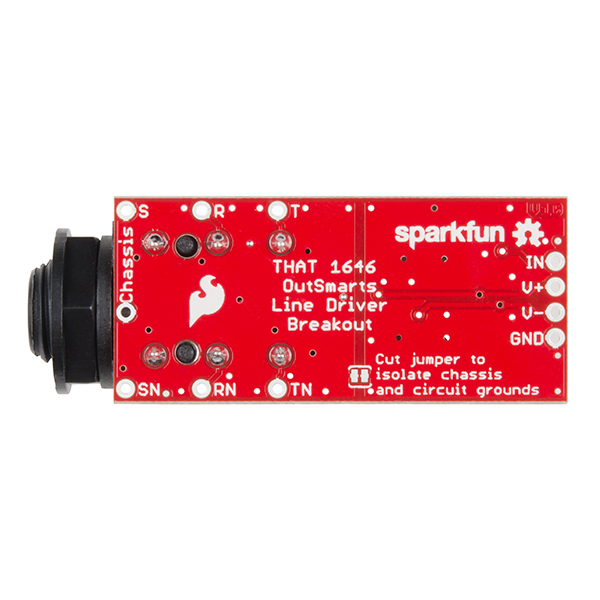SparkFun THAT 1646 OutSmarts Breakout
The THAT 1646 OutSmarts Breakout Board offers an easy solution to adding a balanced audio output to your circuits. The THAT OutSmarts technology has been designed as a high-grade analog line driver and offers a low distortion and high common mode rejection in real-world audio applications. Each breakout board combines the THAT 1646 IC, its supporting components and a ¼" TRS (Tip Ring Sleeve) socket. With these powers combined, you will find it very easy to use the output drivers on breadboards and in projects!
The THAT 1646 OutSmarts Breakout and its sibling, the THAT 1206 InGenius Breakout, perform mirror-image signal conversion. While the InGenius is a balanced-to-unbalanced input receiver, this OutSmarts is an unbalanced-to-balanced output driver. We have made sure to break out each pin you need to utilize the OutSmarts board including the unbalanced input (IN), the positive and negative power supply rails (V+, V-) and, of course, ground (GND). Additionally, adjacent to each leg of the socket are test points for the signal (T, R, S) and normal (TN, RN, SN) contacts.
- Schematic
- Eagle Files
- Hookup Guide
- Datasheet (THAT 1646)
- GitHub
SparkFun THAT 1646 OutSmarts Breakout Product Help and Resources
THAT InGenius and OutSmarts Breakout Hookup Guide
March 30, 2017
Learn about the benefits of balanced signal transmission, and how to apply the THAT InGenius and OutSmarts breakouts.
Core Skill: Soldering
This skill defines how difficult the soldering is on a particular product. It might be a couple simple solder joints, or require special reflow tools.
Skill Level: Noob - Some basic soldering is required, but it is limited to a just a few pins, basic through-hole soldering, and couple (if any) polarized components. A basic soldering iron is all you should need.
See all skill levels
Core Skill: Programming
If a board needs code or communicates somehow, you're going to need to know how to program or interface with it. The programming skill is all about communication and code.
Skill Level: Rookie - You will need a better fundamental understand of what code is, and how it works. You will be using beginner-level software and development tools like Arduino. You will be dealing directly with code, but numerous examples and libraries are available. Sensors or shields will communicate with serial or TTL.
See all skill levels
Core Skill: Electrical Prototyping
If it requires power, you need to know how much, what all the pins do, and how to hook it up. You may need to reference datasheets, schematics, and know the ins and outs of electronics.
Skill Level: Rookie - You may be required to know a bit more about the component, such as orientation, or how to hook it up, in addition to power requirements. You will need to understand polarized components.
See all skill levels
Comments
Looking for answers to technical questions?
We welcome your comments and suggestions below. However, if you are looking for solutions to technical questions please see our Technical Assistance page.
Customer Reviews
4.1 out of 5
Based on 7 ratings:
1 of 1 found this helpful:
Balancing the unbalanced
Bought 10 of these and installed them in an old dbx patch bay, replacing the jack modules. Connected 16v from a 51x psu and I now have a perfect 10ch unit to not only balance my old hw synths going into an Euphonix AD converter, but it also works as a line booster so I can connect them directly to the converter. Sounds great!
1 of 1 found this helpful:
Great addition to Modular Synth
I read about this in SoundonSound magazine and immediately ordered. Adding a pair of these to my Synthesizers.com synth was easy and gave me balanced outputs making integration with a DAW much better. Very easy to use, worked first time and performs brilliantly.
1 of 1 found this helpful:
Super useful!
These breakout boards are super flexible and extremely easy to use. I installed a pair in a compressor mod using the Normalled outputs to feed a transformer and it works great. Super flexible
6 units are working smoothly
This is a very good product and a sincere product. If possible, I would like the width to be made thinner to match the width of the connector. If the connector is a metal neutrik NRJ6HM-1, the strength will be increased.
Balancing the unbalanced
Bought 10 of these and installed them in an old dbx patch bay, replacing the jack modules. Connected 16v from a 51x psu and I now have a perfect 10ch unit to not only balance my old hw synths going into an Euphonix AD converter, but it also works as a line booster so I can connect them directly to the converter. Sounds great!
Simple solution when Balanced is best
The THAT 1646 IC is the best, in my experience. Extremely fast. Zero latency. Zero noise. This cool Sparkfun package will add a professional touch to any audio device. Quite handy for pushing Class D high wattage amps in the music making world. Requires a bipolar DC supply, about 10 mils, but those are easy to come by.
Dissapointed
Purchased two and neither work. Tested both boards with a sinewave 1kHz 5Vpp input signal. One of the boards had a clean TRS Tip output signal but the signal on the Ring was distorted. I tested with several bipolar power supplies and double checked the test setup and probe configuration. The second board had distorted output for both signals and the Ring was NOT 180 degrees out pf phase, it was in phase.
I was hopeful because THAT corporations specs for the 1646 are nice. Not exactly sure were the faults lie, board or chip issue. This is not a complicated circuit and I will do further investigations as time permits.
Head over to https://www.sparkfun.com/returns if you'd like a refund





This board would be so much more useful if it either came without the TRS jack or had a dual footprint for a TRS and an XLR3. XLR3 is the right way to send balanced audio. 1/4" TRS was traditionally reserved only for inserts and returns.
I've designed several products with the THAT1646 (and the TI equivalent, the DRV134) and the part is great. But there is an important caveat noted in the datasheet, under Applications on page 6:
"2. Both devices must be driven from a low- impedance source, preferably directly from opamp outputs, to maintain the specified performance."
Look at the part's internal schematic. It has a moderate input impedance, 5kΩ. The pin labeled "GND" really isn't a power-supply return pin, it is just a side of another 5kΩ resistor whose other side goes to the op-amp's input. The op-amp inside the 1646 is configured as a non-inverting amplifier, so if you look at the common configuration for such an op-amp, you'll see that this second resistor is the Rin part of the feedback network.
What does this mean? It means that if you drive it from a source without low-impedance drive, such as the wiper of a pot, the balance is wrecked. The result is asymmetrical drive, and that asymmetry is a function of the source impedance. This asymmetry might not be a problem in many applications where the connected receiver is a differential amplifier (THAT1200-series, INA217, or a diff-amp built from a pair of op-amps, or a transformer) and in circuits with the standard ±15 V rails and standard line-level (+4 dBu) audio. But if you power the 1646 from reduced rails, like its ±5 V lower limit, you'll clip easily.
So you definitely want to drive this guy with an op-amp.
This is great, I love it but I need it with an XLR-3 connector. Is the board layout compatible with a board mount XLR connector as well? Perhaps Neutrik? If not, can you offer with the TRS connector unpopulated so I'm not paying for a connector I can't use?